
My Trailer Trash Glow-Top pedalboard sports a combination of digital and analog effects for maximum flexibility. Top row: Line 6 DL4, Line 6 MM4, and ReAmp box. Middle row: Line 6 Verbzilla, Boss OC-2, Z.Vex Ringtone, Keeley Compressor, Planet Waves tuner, and Z.Vex Box of Rock. Bottom row: HomeBrew Electronics Power Screamer, Loop-Master 5-Loop Effect Switcher, DigiTech Whammy, and Snarling Dogs Whine-O Wah. Side: Rocktron Banshee Talkbox and Z.Vex Tremolo Probe.

The underside of my Glow-Top pedalboard reveals a highly organized matrix of cables and electronics
designed to ensure great tone and optimum reliability.
Throughout my career, I’ve done corporate gigs for large companies like Microsoft. For these kinds of shows, I typically have to learn about 40 cover songs by artists ranging from Michael Jackson to Bryan Adams, Jay-Z, Maroon 5, Journey, and U2. These artists are very different, so I have to be able to pull up the correct sounds for each song as fast as possible. Having a large pedalboard with different output options allows me to have a vast palette of tones available at the stomp of a switch. In this month’s Tone Tips, I’ll give you an overview of what I call my Monster Board.
I have pedalboards of various sizes, and they all serve different functions. If I need a board that’s easy to modify, I build it on one of several Pedaltrain models. For a board that needs to stay hardwired, I call James “Rooster” Olson at Trailer Trash Pedalboards. Most of my knowledge about signal flow and how to build a large board has come from working with James. When building a large board, one of the first pieces of gear you’ll want to purchase is a buffer.
Buffers send a nice, strong signal to the front of your amp. My favorite buffer is the Axess Electronics BS-2, because it has a split output and an isolated output. I use the split out to go straight to my tuner. That way, I don’t have to have my tuner be first in line in the signal chain. The buffer works in conjunction with my Loop-Master 5-Loop Effect Switcher, so I can always have my tuner on. This way, I have the option to tune while I’m playing or tune silently. I mainly use the BS-2’s isolated out when I do sessions. This signal goes to a jack I had installed on the side of my board. From that jack, I can go into a DI box and send the engineer a completely dry and unprocessed sound. Later, I can use this for reamping tracks with my ReAmp box.
The second piece of gear that you should have on a large board is a true-bypass looper, like the Loop-Master I mentioned above. Typically, pedals without true-bypass circuitry affect your high end, and a true-bypass looper keeps such devices out of your signal chain when they’re not being used. Another cool feature about a true-bypass looper like the Loop-Master is that you can have one of the switches engage several pedals at once. For instance, you could have an overdrive, compressor, delay, and a reverb all wired to one button. Hitting that single button during a solo engages all four pedals.
You might want to consider having send/return jacks built into the side of your board. Installing send/return jacks and wiring them to a button on the Loop-Master allows me to have “guest pedals” that are not mainstays on my board. I use my send/return jacks mainly for a Rocktron Banshee Talkbox. I don’t use it enough for it to be mounted on my board, so the send/return jacks are the perfect compromise.
As a side note, let’s address getting a good talk-box tone really fast. At the last Microsoft function I played, our band played “Hella Good” by No Doubt and “It’s My Life” by Bon Jovi. Both songs have talk-box parts. One of the biggest issues I’ve encountered with using a talk box is getting the notes to have enough body. Many times when I hear guitarists use a talk box, the tone sounds more like a high-pressure garden hose than an instrument. To get around this, I’ll run an overdrive pedal into an octave pedal before I hit the talk box. Octave pedals send several layers of harmonic information to the talk box and fill out the sound before it comes out of the tube and goes into the microphone.
Okay, back to pedalboards. Enlisting the help of an experienced tech like James Olsen is always a good call when building a complex board. Paying someone to make sure your pedalboard is ready to be knocked around by airlines and shaken in trailers is money well spent. If you’re going to build your own Monster Board, make sure you have pedals with quality parts and well-built cables connecting everything. In my experience, when a rig stops making sound, nine times out of 10 the issue lies somewhere in the pedalboard. Take the time to make sure everything is properly and securely hooked up. Once you have the peace of mind that everything is settled on the technical side, be sure to give your creative legs a stretch by experimenting with different sounds.






![Rig Rundown: Russian Circles’ Mike Sullivan [2025]](https://www.premierguitar.com/media-library/youtube.jpg?id=62303631&width=1245&height=700&quality=70&coordinates=0%2C0%2C0%2C0)

















